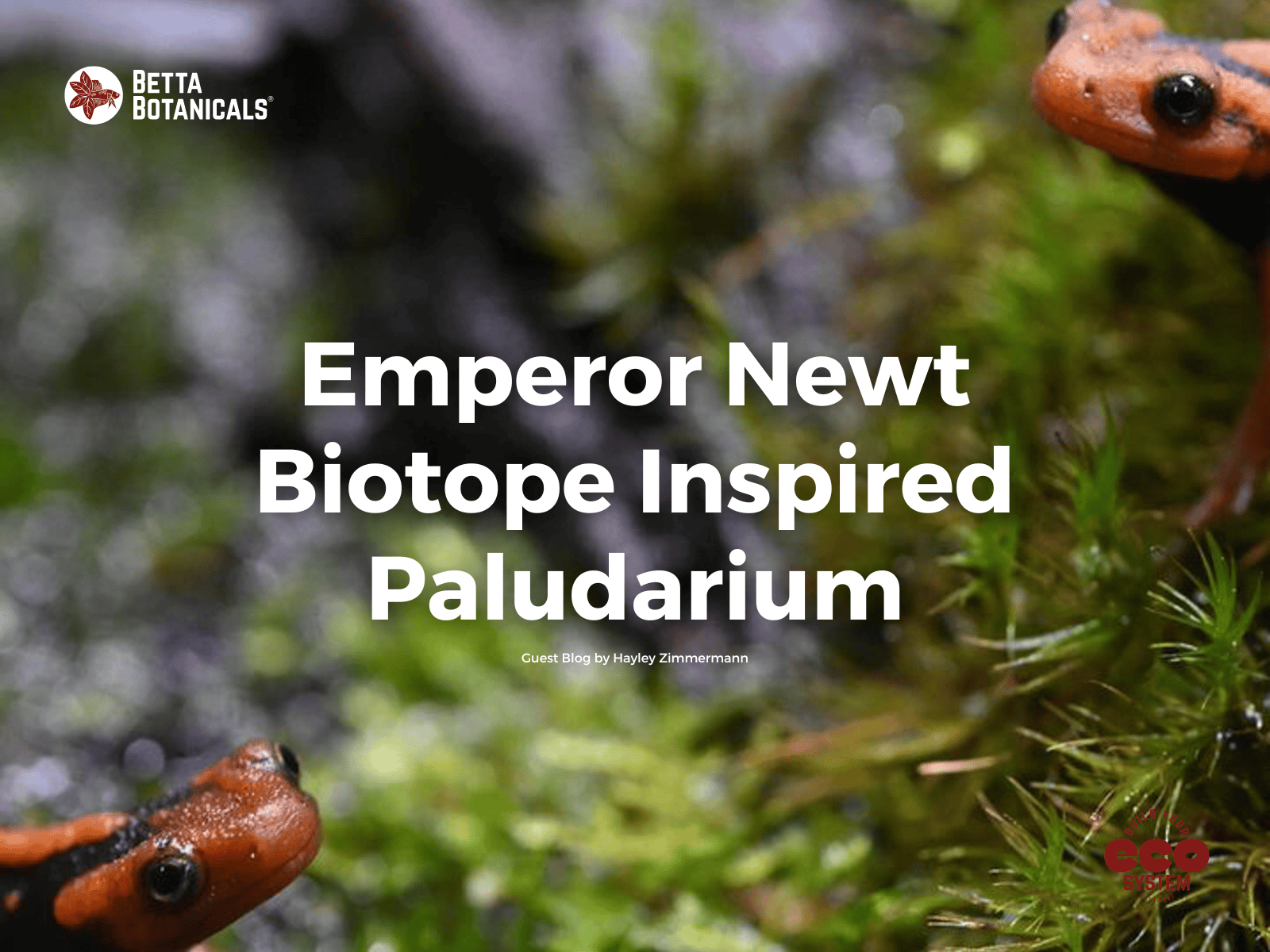Biotope, Blackwater & Botanical Method: Which is Right for You?
If you’ve spent time on social media, aquarium blogs, or forums, you’ve likely come across the terms blackwater aquarium, botanical method aquarium, or biotope aquarium. What do these terms mean? Why would fish require something other than clear water? Well, that depends entirely on the fish you keep and where they come from, your preferred aesthetic, and the main driving goal behind why you want to have aquariums in the first place.
Here's the quick and dirty break down of the key differences between the three types of botanical habitats:
- Biotope aquariums aim to recreate specific ecosystems based on a geographic location. Botanicals are used, but the water may or may not be tinted. The water parameters and stocking choices are determined by the inspired ecosystem and its location around the globe.
- Blackwater aquariums are usually inspired by the blackwater river systems of South America and Southeast Asia. The pH extremely low and there are very few dissolved minerals in the water. Plants are adapted to these low light environments, and fish have evolved in acidic water conditions.
- Botanical method aquariums blend and bend the two above categories. Botanicals are used, but the water may or may not be tinted. Botanicals are used, but they are not replicating a specific geographic location. The water may be tinted, but it is not necessarily low in pH.
At first glance, each aquarium type can appear the same – they each have similar elements: botanicals. But upon closer inspection, you'll notice differences in the plant and animal stocking and the water chemistry. Let’s break down these three types of tinted aquariums to help you understand which option is best for you. Don't worry, they are all related and have definable key differences.

Photo by @CD_Scapes Biotope-Inspired Aquarium.
Do Biotope Aquariums Replicate a Specific Habitat?
The word biotope comes from the Greek bios, life, and topos, place. The term was initially introduced to the scientific community in 1908 and was described as a habitat in which particular plants and animals live.
Biotope aquariums aim to recreate specific replicas or ecosystems found in a identifyable geographic location. All the plants, fish, and botanicals added to these ecosystems are chosen to closely match their inspired habitats. Biotope aquariums can be tinted or clearwater, depending on the ecosystem you are attempting to recreate. Think of the square and rectangle metaphor: biotopes can be botanical method or blackwater aquariums, but botanical method and blackwater aquariums are not necessarily biotopes. Biotope aquariums go so far as to replicate the look of the substrate, the fish species, the microfauna species, and the plant species. Enthusiasts will go so far as to import plant species direct from the habitat, and purchase wild caught fish from the specific river drainage of the habitat they are replicating. The Biotope Aquarium Project is a great resource to get your feet wet and learn more about how to create a biotope aquarium.
Exploring the Differences: Water Parameters and Geographic Location
Biotope aquariums aim for specific water parameters determined by the ecosystem you are attempting to recreate. For example, the water chemistry for a peatland biotope is different from a South American river biotope. If your goal is to create a biotope aquarium, researching the specific water parameters, plant life, botanicals, and organisms that call that ecosystem home are your first steps.
Tip: Remember that your substrate choice can impact your water’s pH in the same way that botanicals or chemical buffers do. It is important to test all substrates before using them if you do not know if they are inert.

Photo by @TheGilltyBetta Otocinculus catfish on some botanical materials.
Best Fish Choices for Biotope Aquariums: Matching Flora and Fauna
Any fish can be kept in a biotope aquarium. However, the stocking choices are usually curated based on the ecosystem you are trying to recreate. Remember that biotopes are often bioactive, meaning that the stocking includes fish as well as other critical flora and fauna that help things run smoothly. For a quick breakdown, ecosystems include biotic (living) and abiotic (non-living) factors that interact to maintain balance. For example, your fish, inverts, and nitrifying bacteria are biotic, while the botanicals and substrate are abiotic. Remember that ecosystems have different levels and different levels of interaction.

Betta Macrostoma in a blackwater aquarium at Betta Botanicals.
What Are The Key Features of a Blackwater Aquarium?
Blackwater aquariums are (usually) a type of biotope aquarium. However, these tanks have a couple of differences that set them apart from other styles of fishkeeping. First, heavily-tinted water. Second, an extremely low pH, GH, and KH. The plant life is often adapted to darker environments or devoid all together, and the fish prefer acidic conditions. Blackwater aquariums are inspired by blackwater ecosystems (such as sandy-bottomed river systems) found in nature, so the botanical and stocking choices are often based on the particular ecosystem. With that said, you can throw in some Caribsea Sunset Gold Sand, and your favorite botanicals from around the globe, and then fill the tank with RODI water and throw in neon tetras and bettas and have a pretty fantastic blackwater aquarium.
Unveiling Blackwater Aquariums: Inspired by Amazonian Ecosystems
Blackwater aquariums are inspired by the blackwater river systems of Amazonia (the region around the Amazon River Basin and its tributaries). The Rio Negro in the Amazon is the sixth-largest river in the world and the largest blackwater river in the world. The water in this region is low in mineral count, making it easily influenced by acids from decomposing organic materials (leaves, seed pods, wood/bark, etc.). As we know, when botanicals decompose, they release humic substances such as humic acid, tannic acid, and fulvic acid. The concentrations of organic materials are so high that the pH of the rivers and tributaries can reach as low as 3.8-5.4.
Betta Hendra Paludarium at Betta Botanicals.
Do Blackwater Aquariums Require Specific Water Parameters?
Blackwater aquariums are unique to the fishkeeping world in that they aim to achieve specific water parameters. The water is low in minerals such as Sodium, Magnesium, Calcium, and Potassium. As such, this fishkeeping method is not ideal for those looking to keep inverts that rely on minerals to calcify their shells. The low GH and KH of the water remove any buffers, so the pH can drop to extremely acidic levels. Many blackwater enthusiasts aim for a pH of 3.6 to 5.4 (7 is neutral). The water also has low conductivity, making it similar to pure rainwater.
There is very little bacteria activity in blackwater aquariums because nitrifying bacteria are inhibited in acidic conditions. But no worries! Toxic ammonia (NH3) is naturally converted into ammonium (NH4) in acidic water, which your plants can still uptake as nutrients.
How do I Know If My Fish Would Like a Blackwater Aquarium?
Many blackwater enthusiasts stock fish native to South America, including varieties of catfish, tetras, and dwarf cichlids. Certain varieties of bettas (although endemic to Asia & the Indopacific) are also well-suited to blackwater environments. For example, betta hendra thrive in acidic conditions. Their native peat swamp habitats closely resemble blackwater systems.
Photo by @WabiScape a Botanical Method Aquarium with Tiger Barbs.
Embracing the Botanical Method Aquarium: Freedom and Experimentation
At first glance, botanical method aquariums can resemble blackwater aquariums with their tinted water and botanical substrate. However, these tanks don't aim for specific water chemistry and don't necessarily try to recreate a specific ecosystems. With botanical method aquariums, you have a lot of freedom to experiment! Sometimes the plants and botanicals chosen for these tanks mimic specific ecosystems, but sometimes they don't. Remember that your botanicals don't have to come from the same region to be used together!
The Role of Water Parameters: pH, Hardness, and Aesthetic Choices
Unlike blackwater aquariums, botanical method aquariums do not attempt to achieve specific water chemistry. Instead, the fish that you're keeping determine the water parameters. When getting started, consider the pH and hardness of your home tap water and your fish's preferred parameters. Sometimes the water is tinted from the tannins released by decomposing botanicals. Other times, the water runs clear. Tinted water is not a requirement for botanical method aquariums and is completely up to your preferred aesthetic and fish keeping practices.
What Fish Are Best For a Botanical Method Aquarium?
Any fish can be kept in a botanical method aquarium. Leaf litter is a part of nature; most aquatic environments contain botanicals of one sort or another. We have always believed that fish are more interesting to observe in botanical method aquariums. This style of fish keeping recreates the fish's natural habitat, encouraging them to display unique natural behaviors. Bettas are a favorite for this type of aquarium as they prefer dark environments with lots of botanicals and leaf litter for shelter. However, other aquarium hobby favorites such as goldfish, angelfish, gouramis, and corydoras can also benefit from botanical method aquariums.
Choosing the Right Aquarium Method: Biotope, Blackwater, or Botanical Method?
Every fishkeeper is different. It's the reason why so many styles of fishkeeping and aquascaping exist in the hobby today. No matter your preferred aesthetic, there's no right or wrong way to keep fish (within reason, of course). For all you #TanninBaes, we hope this overview clears up your questions about the differences between blackwater, botanical method, and biotope aquariums. Let's sum it up:
- Biotope aquariums aim to recreate specific geographic ecosystems.
- Blackwater aquariums are low in dissolved minerals, pH, KH, GH, and usually have tannin stained water.
- Botanical method aquariums may or may not be inspired by a particular ecosystem. Botanicals are used, but the water may or may not be tinted. The water parameters are flexible.
Good luck and happy fish keeping!










Inspire your friends:
What Leaves Can I Feed My Shrimp? Shrimp Safe Leaf Litter!
Macaranga Leaves for Indonesian Blackwater Biotope Aquariums
2 comments
Thank you Ben for great work!!…very nice for reading and very good for inspiration of choosing which aquarium everyone can make it…
You are smart and a very good writer. I appreciate you and your knowledge.